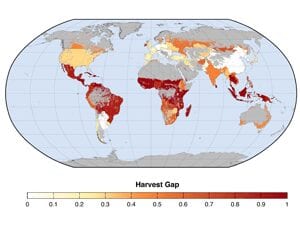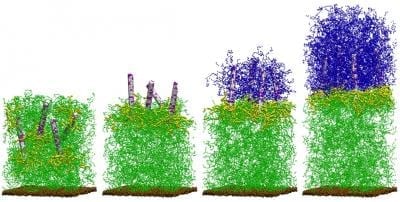
More frequent harvest could substantially boost global food production on existing agricultural lands
Harvesting existing cropland more frequently could substantially increase global food production without clearing more land for agriculture, according to a new study from the Institute on the Environment (IonE) at the University of Minnesota.
The study, published in Environmental Research Letters, tracked global harvest trends of 177 crops between 1961 and 2011. It found that the total amount of land harvested increased four times faster than the total amount of cropland between 2000 and 2011, suggesting that harvest frequency was on the rise. This led the authors to wonder if there might be additional gains to be had by strategically increasing cropping frequency.
“Could existing arable lands get more frequent harvests, and what is the upper limit?” asked Deepak Ray, lead author of the study. To answer that question, he introduced a new concept: harvest gap.
Harvest gap is the difference between actual per-year harvest frequency and the maximum potential frequency. Ray and the study’s co-author, IonE director Jonathan Foley, estimated that on average an extra harvest is being missed globally every two years due to the presence of this harvest gap.
The researchers found that Africa, Latin America and Asia have the highest concentration of potential harvest gaps. Brazil, for example, which on average harvests its croplands nearly once per year, has a harvest gap of 0.9, suggesting that on its current arable lands a second harvest is possible each year. Closing the gap would boost crop production on existing croplands without resorting to further clearing for agriculture, and so could potentially reduce the pressure to destroy additional rain forest. Increased harvest frequency also holds potential for mitigating risk under a changing climate. Worldwide, the researchers found that closing harvest gaps worldwide could theoretically boost production more than 44 percent.
Ray notes the study amounts to “scientific eyeballing,” since only national data were available and only for 177 crops. To fully quantify the potential impact, more local data would be needed, and local farmers would have to weigh the benefits against the costs of additional harvests, which may turn out to be prohibitive.
In addition, the researchers note that efforts to increase crop harvest frequency must also be wary of leading to deterioration of soil, water and the agricultural land base. “Depending on local environmental conditions, agronomic practices and social contexts, increasing cropland harvest frequency could present a short-term gain in crop production, with long-term losses in agricultural yields and environmental conditions. Only if increasing frequency of harvests can be done sustainably is this strategy a potential way to address some of the challenges of crop production and food security,” they write.
Localized studies suggest that farmers around the world already are benefiting from increasing the number of harvests. “Introduction of second crops, generally corn following the primary soybean crop, has increased local incomes across economic sectors,” the report noted. Countries in which cropping frequency already is increasing include Brazil, India and China; however, others, including many African nations, have shown a decline in recent years.
More frequent cropping, the authors said, represents a potentially powerful “third way” of increasing food production, in addition to expanding cropland and increasing harvest yields, both of which are widely studied by IonE researchers.
The Latest Google Headlines on:
Global food production
[google_news title=”” keyword=”global food production” num_posts=”10″ blurb_length=”0″ show_thumb=”left”]
The Latest Bing News on:
Global food production
- The Sino-Russian Land Grain Corridor and China’s Quest for Food Securityon May 8, 2024 at 9:02 am
May and Zhang Hongzhou write about the New Land Grain Corridor (NLGC) developed by China and Russia and how it could impact global food dynamics.
- Alfa Laval leads the way in sustainable food processing with heat transfer technology to cut emissions in halfon May 8, 2024 at 12:31 am
According to the UN, we will need up to 70 percent more food to feed the world by 2050. At the same time, the food system accounts for a third of global greenhouse gas emissions and exerts growing ...
- We cannot afford another lost year for food and climate actionon May 7, 2024 at 10:04 am
Last December, organizers of the annual UN climate negotiations finally got around to dealing with agriculture as a source of carbon, using the occasion to unveil a non-binding so-called “roadmap” for ...
- Food startup Hungryroot uses AI to reduce waste, a major climate offenderon May 7, 2024 at 5:50 am
Hungryroot, a nine-year-old startup in New York, is trying to deliver precise portions to users to cut down on waste.
- Introduction: Bringing the world’s food production in line with global climate goalson May 7, 2024 at 5:17 am
About 30 percent of greenhouse gas emissions come from food production. Human society faces tremendous challenges in remaking its food system in an age of climate change — but it has some powerful ...
- Food Diagnostics Services Market Insights, Applications, Production, Revenue, and Future Projections Until 2032on May 7, 2024 at 1:58 am
The Global Food Diagnostics Services Market estimated value was at US$ 14.8 Bn in 2022 and is projected to reach US$ 21.6 Bn by the end of 2032. Newly released data for Global Food Diagnostics ...
- Global Food Grade Carrageenan Market to reach a valuation of US$ 2.6 billion by 2034, FMI Projectionon May 6, 2024 at 9:35 pm
The global food grade carrageenan market will reach a valuation of US$ 1.3 billion in 2024, attributed to factors such as emerging markets for processed foods. The trend is set to create new ...
- Changes in Farm and Food Production Can Cut Greenhouse Emissions by a Thirdon May 6, 2024 at 7:59 pm
The agriculture system that produces the world’s food can cut greenhouse gas emissions while continuing to feed the world. The global agrifood system presents a huge opportunity to cut almost a third ...
- Global Food Prices Reflect Mixed Trends in April Amidst Supply and Demand Dynamics, FAO Report Findson May 4, 2024 at 9:28 pm
The FAO's April report highlights mixed trends in global food commodity prices, with modest upticks in meat, vegetable oils, and cereals offsetting drops in sugar and dairy, highlighting the complex ...
- Partnership Opportunities to Transform Food Systemson April 30, 2024 at 2:18 pm
This report explores how public-private partnerships can help transform global food systems to be more sustainable, efficient, and equitable while adapting to climate change and meeting the increasing ...
The Latest Google Headlines on:
Cropping frequency
[google_news title=”” keyword=”Cropping frequency” num_posts=”10″ blurb_length=”0″ show_thumb=”left”]
The Latest Bing News on:
Cropping frequency
- Climate Change Ravages Mehrab Kaka's Wheat Crop In Khyber Pakhtunkhwaon May 4, 2024 at 1:00 pm
In the annals of human history, the gravest threat to survival isn't envisaged through the lens of World War III or economic downturns, for wars may ...
- Crop Yield Definition, Formula, Statisticson May 3, 2024 at 5:01 pm
Crop yield is a standard measurement of the amount of agricultural production harvested per unit of land area. It's the measure most often used for cereal, grain, or legumes and it's typically ...
- Crop Insurance 101: The Basicson May 1, 2024 at 5:00 pm
Crop insurance is exactly like it sounds: an insurance product designed to help shield farmers against a myriad of potential risks, ranging from adverse growing conditions to market fluctuations. This ...
- Field of vision: How woman-run Stereolabs brings AI to agricultureon May 1, 2024 at 5:20 am
Stereolabs has spent the past few years integrating its ZED camera into agricultural equipment to build autonomous, data-driven machines.
- D.C. climate-tech company to launch its first satellites with SpaceXon April 29, 2024 at 11:55 am
When SpaceX launches this D.C. company's first two satellites later this year, they will be the first of many to come, according to its CEO.
- Best gaming headset 2024 - the cream of the audio cropon April 25, 2024 at 4:39 am
Adding one of the best gaming headsets to your setup can have a massive impact on the quality of your playtime, from sharpening your directional audio to giving those rumbling gunshots the bassy ...
- Advancing crop breeding through targeted genome modificationon April 24, 2024 at 5:00 pm
Modern crop breeding is entering a new era of genome design, led by genome editing technologies as mainstream tools for targeted genome modification. In a review published in Nature Reviews ...
- Wheat Extending Strength on Deteriorating Crop Conditionson April 23, 2024 at 11:30 am
MPLS is bringing up the rear, but still with 5 to 7 ¼ cent gains. After the close, NASS reported that the US winter wheat crop 17% headed, 4% above the normal pace. Condition ratings for the crop ...
- Crop planting slowed last week by rainon April 22, 2024 at 4:59 pm
The U.S.D.A. crop report shows there were only three days suitable for fieldwork due to the weather. Corn planting hit 13% complete by the end of the week — up from four percent last week.
- Palia: Crop Growing Guideon April 21, 2024 at 5:00 pm
Gardening is a useful skill in Palia. Here's a complete crop-growing guide for Palia players, including getting tools, planting seeds, and more. Palia is a fun MMO adventure that players can play ...











